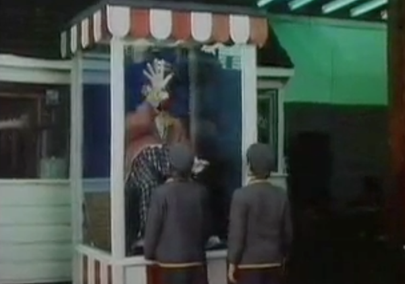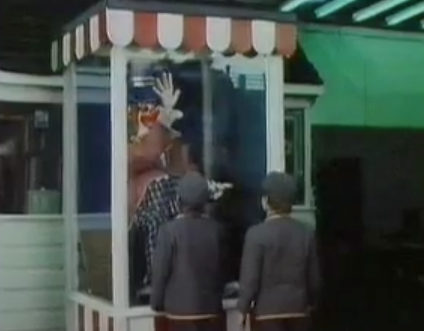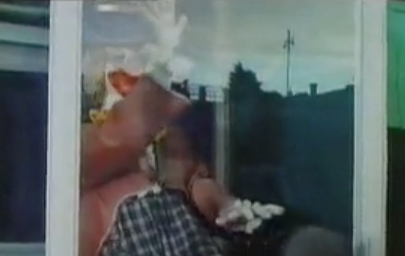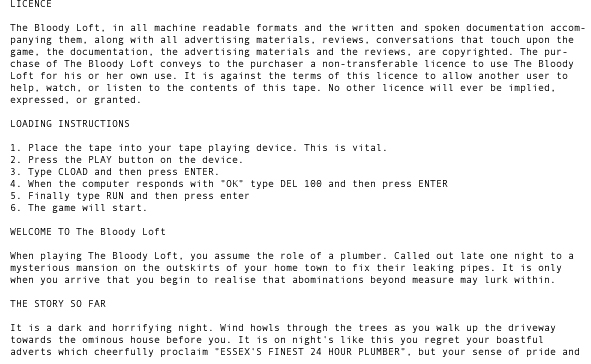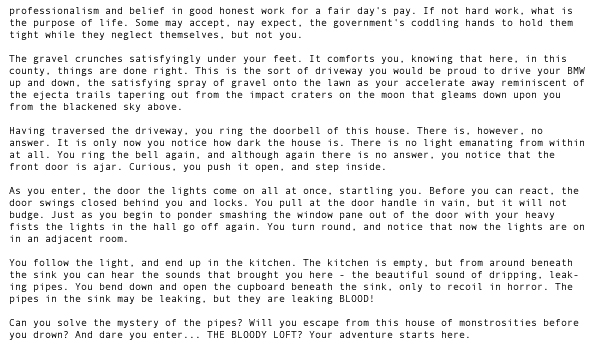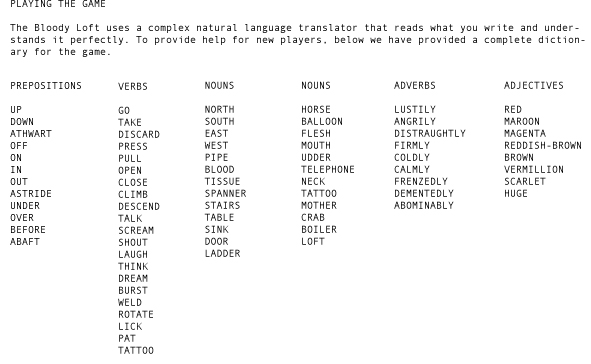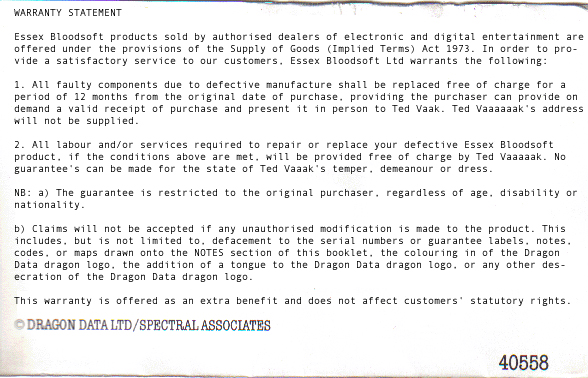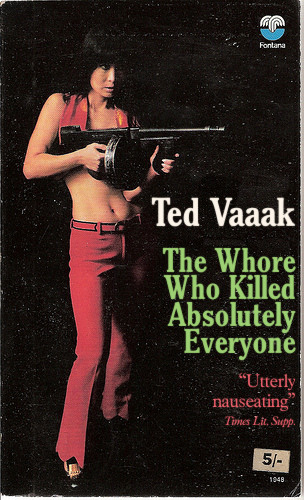[Notes: This is an incomplete collection of various film’s review on the Essex Terror! website (but not in the Essex Terror magazine). They are in no particular order, due to laziness on my part. And also a large number of images are missing. I am sorry.]
***
The Trip To The End Of Southend’s Pier
Production year: 1987
Country: UK
Language: German
Cert (UK): Unrated
Runtime: 124 mins
Directors: Sir Terald Vaakenheim
Cast: Ted Vaaak
Ted Vaak’s The Trip To The End Of Southend’s Pier, from 1987, is now getting a re-release and it’s pretty scary and entertaining stuff, though I always get the feeling that nothing in it lives up to the tremendous opening section. It begins with Ted Vaaaak (credited inexplicably as Sir Terald Vaakenheim for his role as director, but as plain Ted Vaaak for his acting and his writing) wandering muttering and confused down Southend Pier, early morning mist lending everything an unreal and apocalyptic air. Filmed in one unbroken 25-minute sequence, Ted’s stuttering, near heartbreaking, waltz along the deserted Essex landmark is a thing of genuine beauty, reminiscent of the climactic scene in Tarkovsky’s Nostalghia, and it is so affecting it often threatens to remove the very air from your lungs and constrict the muscles in your chest. From then on, things tend to slip away and get a little broad for my tastes, and the scenes featuring his tortured internal dialogues with a benevolent celestial Margaret Thatcher seem astonishingly dated, though it always remains watchable. 3/5
Peter Bradshaw is the Guardian’s film critic. This article was originally published in the Guardian, and is reproduced here without permission.
***
Anus Horribilis
Production year: 1994
Country: UK
Language: English
Cert (UK): 18
Runtime: 74 mins
Director: Krebva Trells
Cast: Michael Praed, Chelsea Charms, Angela Lansbury
This little seen British horror film has a controversial reputation that far exceeds its actual influence. The story, a loose recreation of A Journey To The Centre Of The Earth, involves Professor Hardwig (Michael Praed) and his team of scientific explorers adventuring their way through Prince Charles’s monstrous anus, through which they expect to find a doorway to Hades. Along the way they battle innumerable monsters, including an horrifically deformed Queen Victoria (Chelsea Charms), the zombie Queen Mother (Angela Lansbury) and a hideous half horse/half Henry VIII abomination (this, astonishingly, is just overdubbed reused footage of Ray Harryhausen’s centaur from The Golden Voyage of Sinbad). One can only assume that all of this is intended to be satirical. It is, however, impossible to tell.
Peter Bradshaw is at least not Xan Brooks
***
Brewster’s Millennials
Production year: 1999
Country: UK
Language: English
Cert (UK): 18
Runtime: 89 mins
Director: Ted Vaaak
Writer: Richard Curtis
Cast: Alan Cumming, Lenny Henry, Donna Air
8 years after the unexpected success of Bernard and the Genie, Alan Cumming, Lenny Henry and Richard Curtis teamed up once again for this BBC Christmas Special. A loose remake of Brewster’s Millions, the setting this time was relocated to London and the time to the very last month of the millennium. Given £30 million to spend before midnight on the 31st December 1999, if Monty Brewster (Cumming) fails he doesn’t just forfeit an even larger fortune but all of civilisation, as the devil himself (Ben Elton) will rise from the depths and enslave humanity for 1000 years.
Entirely formulaic in typical Richard Curtis style, Ted Vaaak’s influence on proceedings is relatively muted until the final ten minutes, when it’s revealed that the entrance to hell is through the belly button of Monty’s best friend Spike (Henry), a monstrous “inny” that goes down forever and ever to the unspeakable lands of doom. As demonic perversions begin to escape, Monty’s spending spree becomes ever more desperate and unpleasant, and the final scene would have been considered unbroadcastable in a gentler decade.
Peter Bradshaw will never knowingly leave a film unspoiled
***
Let Them Eat… Us!
Year: 2013
Country: UK
Language: English
Cert (UK): 18
Runtime: 95 mins
Director: Ted Vaaaak
Writer: Ted Vaak
Cast: David N. Guy, David N. Guy, David N. Guy, Tilda Swinton
Idiotic satire imagining a future where the solution to reducing the EU’s butter mountain is to force every citizen of Great Britain to drink 3 gallons of it every day. Of course the vile upper classes conspire to pay the poor to eat their shares of the congealed pie, leading to a stratified society where a person’s social status is inversely proportional to their weight.
The film takes a turn for the malevolent about half way through, starting with a series of attacks on the thin by the fat, escalating quickly through a series of Clockwork Orange-esque outrages, and appearing to culminate in an absolutely horrific nightmare where a group of overweight thugs (David N. Guy and David N. Guy) fight their way into Buckingham Palace and take our monarchs hostage. The gargantuan revolutionaries cut strips of their own flesh from their bodies and force feed the King (David N. Guy) and Queen (Tilda Swinton) the horrific meat of their subjects until their withered stomachs burst, and from the corpses their livers are harvested for a celebratory meal by their working class assailants.
And yet even that is not the worst of it. A final scene in which this team of obese terrorists hijack a plane, commandeering the kitchen and eating all of the food until the plane is so overladen it crashes into the Empire State Building, is, both scientifically and politically, a provocation too far.
Peter Bradshaw forgives no man nor no woman neither.
***
Multi-Storey
Production year: 2014
Country: UK
Language: English
Cert (UK): 18
Runtime: 81 mins
Director: Ted Vaaak
Writer: Paul Rose
Cast: Tom Hardy, Helen Mirren, Tom Hollander, Helen McCrory, Tom Hiddleston
A desperate attempt to cash-in on the current craze for single building actioners ( Dredd, The Raid, Attack The Block and countless others), Multi-Storey is, perhaps, Essex-based savant Ted Vaaaak’s most deeply generic work yet, which is some achievement considering his dedication to the form.
Shot in “real-time”, Multi-Storey follows unwitting everyman hero Alan Banger (Tom Hardy) in his attempt to retrieve his car from the roof of a car park run by local mob boss, Barry Shooter (Helen Mirren) and return home after a miserable night out as (an abandoned) designated driver.
The car park is, we’re told, the tallest in Essex, and Alan must fight his way across and up each of the four floors, facing off against a vast array of henchmen, henchwomen and even, inevitably, henchchildren.
The pace is largely relentless for the first hour but breaks down once he reaches the ticket machines. The twelve minutes it takes for Banger to validate his ticket kills the momentum of the movie stone dead, and is a serious error of judgement which not even the astonishing single-take multi-level car chase escape and Helen Mirren’s truly demented death scene can rectify.
Imagine Peter Bradshaw stalking across the moors
***
The Barbs

Year: 1981
Country: UK
Language: English
Cert (UK): 18
Runtime: 63 mins
Director: Ted Vaaaak
Writer: Uncredited
Cast: Julian Sands, Patricia Pearcy
Monstrous horror in which newlyweds Terrance (newcomer Julian Sands) and Barbara (Patricia Pearcy, returning here to the genre in which she so memorably made her name in the classic Squirm) inherit a farm in the abject wastelands of rural Essex. Horrified by the sinister local population, they install a huge barbed wire fence around their entire estate to keep them out. But when lightning strikes the fence in a freak storm, the barbed wire stops being the protector and begins to be the aggressor.
In lesser hands, this premise could seem absurd, but here the story is handled deftly, and the creeping barb wire snakes are truly mesmerising.
The film was shot on location across the Dengie, and as such there will be special showings at both The Ritz in Burnham and The Embassy in Maldon throughout the week, in a double-bill with Raiders Of The Lost Ark.
This review was originally published in The Maldon And Burnham Standard on 23rd January, 1982. It has been recollected here without permission of either the publication or its original, and unremembered, author.
***
The Brothers That Looked Exactly Alike
Production year: 2014
Country: UK
Language: English
Cert (UK): U
Runtime: 283 mins
Director: Ted Vaaak
Writer: Michel Houellebecq
Cast: Nathan Fillion, Jérémie Renier

An unlikely and unnecessary remake of Twins, this time presented with a modern twist. Removing the single joke of its source material, this time the long-lost brothers are physically identical, but while Julius Benedict (Nathan Fillion) is a charming and successful All-American business genius, he is to discover with a shock that his brother, Vincent, is French.
Originally commissioned by the French State Department as a propaganda piece to help repair damaged Franco-US relations in the aftermath of the Iraq war, this long-delayed project seems a strange venture for veteran director Ted Vaaaak, especially at this late stage in his career. Apart from continuing his recent interest in twins (The Twins Of Death And Disease, The Parent Trap 3), none of his usual recurrent themes of mordant body-horror, retrograde misogyny or conservative Essexism are in evidence here. Instead we have almost five hours of jokes about snails.
Peter Bradshaw will never die.
***
The English Disease
Year: 2012
Country: UK
Language: English
Cert (UK): NA
Runtime: 23 mins
Director: Ted Vaaaak
Writer: Ted Vaaak
Cast: Ted Vaaak, Danny Dyer, Paul McCartney, Richard Ayoade, Lucy Pinder
This misguided video, funded by the Kick Racism Out Of Football campaign for sensitivity and awareness training sessions, was never used by the charity, and certainly wasn’ ever intended to be made available to the public. However, its leak onto the internet this week has reignited the storm over racism in the English game, escalating bitter disputes between leading figures and bringing forth such a sustained flurry of lawsuits there is a chance that this could finally be the end of director Ted Vaaak’s career.
Set on the eve of Euro 2012, The English Disease is centred around the murder of a fictional and unnamed England player who, we are told in a wall of introductory text, is the first ever gypsy to play for the national team. From their, the story is told in a series of flashbacks instigated by the investigating detective’s interviews with the players and staff.
The player is shown being misunderstood, ignored, ridiculed, bullied and humiliated by both the manager Roy Stodgson (Paul McCartney) and the players John Scary (Danny Dyer), Ashley Cruel (Richard Ayoade) and Rio Murderhand (Noel Clarke), culminating in his eventual (never shown) murder in the changing rooms before the opening match of the tournament.
With its startling depictions of the corrosive culture at the heart of English football, and the dangers of a dresssing-room “don’t tell” code of silence in prolonging abuse and protecting abusers at the expense of the abused, this could have been an excellent tool in the fight against prejudice. Unfortunately it is undone by a number of baffling artistic decisions, not least the use of rhyming couplets for the majority of the dailogue. “Oh god, you gypsy, don’t you know that I hate you / If you think this is bad well I haven’t even begun to slate you” might well be the worst line sung this year, although the film is replete with others that run it close.
All that pales into insignificance behind the casting of Ted Vaaak himself as The Player. Although Vaaak claims Traveller heritage through an unverified grandmother, the apparent whitewashing of the character in a piece such as this is problematic – not to mention disquieting – at best, and insultingly crass at worst. Additionaly, the sight of the septuagenarian Vaaak creaking around in an England kit is absurd, sickening, and largely inappropirate for a film intended to be shown to teenage boys.
The inclusion of Tegan Gethard (Lucy Pinder) as the team’s captain was presumably meant to highlighted the other, often unmentioned, unlanced boil on English football’s bloated rump, but any genuine attempt at exposing sexism, even obliquely, is undone by the erotic moaning that overcomes her and the slow-mtion close-ups the director employs every time she is subjected to a “playful” slap by a teammate, which is surprisingly often in a video with a running time of less than half an hour.
Although the killer is never revealed, the final refrain that “Just as surely as whoever laid the final blow / It was also YOU that killed him, that I know”, accompanied with the detective pointing directly at the screen towards us, the viewers, proves to be simultaneously insulting trite and an impressive use of 3D.
Peter Bradshaw cannot be found.
***
The President’s Wife
Production year: 1993
Country: UK/Canada/Italy
Language: English
Cert (UK): 15
Runtime: 93 mins
Director: Ted Vaaak
Cast: Leonard Nimoy, Shannon Tweed

This amiable and largely forgotten comedy of confusion, now available on DVD for the first time, was to be Leonard Nimoy’s last film role for 16 years. He stars here as an aging actor mistaken by an invading alien force for the President. The aliens send an envoy (Shannon Tweed) to seduce Leonard in the equally mistaken belief that his son will become ruler of the world. Towards the end the wittiness dissipates, and an unnecessarily graphic scene where the alien’s human body is ripped apart as she lays a 4 foot egg ruins what had previously been a largely charming twist on an old genre. The epilogue, with Leonard Nimoy perched atop the egg in an apparent attempt to help it hatch, hints at a sequel that was to never be made.
Peter Bradshaw is the Guardian’s film critic. This article was rejected.
***
The School In The Night
Production year: 2001
Country: UK/Spain
Language: Spanish
Cert (UK): N/A
Runtime: 87 mins
Director: Jaume Balagueró
Script: Ted Vaaaak
Cast: Jessica Del Pozo, Federico Luppi
After the success of Los Sin Nombre, his successful adapation of English horror novelist Ramsey Campbell’s story The Nameless, Jaume Balagueró planned on following this up with another film based upon a British author’s horror works. However, La Escuela En La Noche, based upon the short story The School In The Night by Ted Vaaaaaak (who was also responsible for the film’s script), would never see release. The showing this week of an almost complete cut as part of the Barbican’s Horrific Stories season is something of a mixed blessing.
Leda (Jessica Del Pozo) is a lonely ten year old girl. Trapped in a huge and empty school, she spends her days wandering the corridors of this impressive gothic prison. At night, she retreats to her safe haven in the changing rooms, sleeping on the wooden benches and talking to her only friend, a disembodied female voice that rises out of the pipework of the radiator.
Desperate to escape, the voice from the radiator tells Leda of her one chance of escape. Every year on her birthday, all the doors in the school will open, and if she can get to the entrance she will be free. The only problem is the fearsome beast that roams the school after dark. Hunchbacked, fang-mouthed, fingers like hyperdermic needles at the end of swan-wing arms, the first we see of this horrible beast is its face pressed up against the windowpanes at the door to her room, a scene that is a perfectly judged homage to Nosferatu. But all is not lost, for the beast cannot touch her if she does not set foot on the floor. And so begins a terrifying and perilous journey to the other side of the building.
This is where the problems begin to set in. The beast (played by Federico Luppi) is absurd, its awkward lumbering more reminiscent of the beachball creature in Dark Star than of the alien in Alien. The action scenes, mostly consisting of a girl balancing on a banister, are slow, and almost incomprehensibly repetitive. When the most effective scene is of a girl running into a chemistry lab and leaping up onto a table, scattering the stools that are resting there onto the floor, you must surely know that the script has problems.
It is not all bad, though. There is, especially in the early scenes, a perfectly judged atmosphere of nostalgic horror, trading on that illicit thrill that always accompanies walking through public places at night, alone. And I must admit that I enjoyed the section where the beast messily eats an apple that the girl has dropped, hinting at a depravity that the rest of the film never shows.
The final scene, with the beast unmasked and pleading for Leda to stay with him here instead of braving the outside world, is perhaps the best. As she defies him one final time and steps out into the morning air, he sits down on the stairs and cries openly, brokenly, pushing the tips of his needle-thin claws into his tear ducts in an attempt to stem the flow. It doesn’t quite make up for the awkward tedium of the preceeding hour, but it hints at the film this could have been.
This article was written by Peter Bradshaw and first appeared in the Guardian on October 29th, 2010. It is repeated here without permission.
***
The Swollen
Production year: 1964
Country: UK
Language: English
Cert (UK): Unrated
Runtime: 397 mins
Director: Ted Vaaaak
Writer: Ted Vaak
Cast: Ted Vaaak, The Women Of Essex
The Swollen (originally titled Dreams Of The Undressed Witch) was ineminent British director and writer Ted Vaaaak’s first widely released film, finding its way somehow into cinemas across Essex in 1964, including Southend (The Ritz), Laindon (The Radion) and beyond (The ABC in Basildon, although due to heavy traffic it did not open there until 1972). Based upon forced recollections of his childhood nightmares, The Swollen (showing at the BFI this week as part of its Rejection Of Narrative: British Avant-Garde And Confusion season) is often as unwatchable as it is incoherent, and as badly edited as it is written.
And yet beyond the production failings, and the obvious budgetary constraints, glimpses of Ted’s well-hidden genius occasionally emerge, especially in his intriguing sense of metaphor. Three sections stand out amid the tedium. In an early scene, footage of children screaming dissolves into hypnotic imagery of a blood-covered new-born lamb tottering unsteadily to its feet, before cutting abruptly back to the children just as it seems about to take its first step. Viewed contemporarily, this scene takes on a further level of sadness and melancholy as all the children involved are presumably, by now, dead.
Elsewhere, a scene of several women standing in a circle, the camera on the floor looking up at them as they laugh, endlessly, for sixteen unbroken minutes, is at first amusing, secondly distressing, finally terrifying.
This contrasts expertly with the most famous sequence from the film, where the young Ted Vaaak (played by the even-by-then old Ted) watches a young girl (played by a stop-motion doll) undressing in the woods. Utterly silent, as the film itself is holding its breath in anticipation, the piece here has a claustrophobic momentum that builds and builds, from the initial flickering movements of Vaak’s gaunt cheeks as he stares blankly into the trees to the moment when the animated doll removes first her shoes, her socks, her gloves, and then her hair, and afterwards large chunks of her skull. Just as the scene appears set to climax, with the girl? doll? witch? removing the skin from her own face with one hand and the tongue from her mouth with the other, the film abruptly ends.
I alone applauded in the darkness.
Peter Bradshaw Peter Bradshaw Peter Bradshaw Peter Bradshaw Peter Bradshaw
***
THIS IS A DOCUMENTARY
Year: 2014
Country: UK
Language: English
Cert (UK): 18
Runtime: 222 mins
Director: Ted Vaak
Writer: Ted Vaaaaaaak
Billed as Ted Vaaaak’s final film, THIS IS A DOCUMENTARY is a stark and often mesmerising film, that nonetheless swerves so frighteningly at times towards antisemitism and racism that it is impossible to recommend.
The documentary – which starts with a title card that says “This was all filmed on June 16th. A Sunday.” – consists of three narrative strands (titled onscreen as THOSE ABOVE, US, and THOSE BELOW) interwoven together to show the ebb and flow of a single Essex day at all levels of the county’s complex social strata.
US centres on an unnamed and severely overweight man, following him through the various drudgeries of a typical day that is immediately recognisable to us all in the broadest sense – waking, washing, commuting, working, shopping, socialising, finally sleeping once more – even if the details themselves are sometimes disorientating (the sheer amount of whelks that can be consumed in a single day, the way the roads are populated almost exclusively by BMWs or white vans, the coarseness of the language of everyone, and the thickness of their tattoos and the coagulating slickness of their hair).
It is in THOSE ABOVE that the controversies begin to mount. Now we watch a family of Essex aristocrats in a dust-filled mansion, all faded glamour and centuries of neglect. Each member of the family is a gaunt cadaver dressed in high Victorian fashion. Their withered arms, which hang limp at their sides, are useless and unused: instead a coterie of servantslaves cater for their every whim – dressing, feeding, cleaning, stroking. This family, and those that are their equals, are functionally incapable of attending to themselves, yet the film makes clear this is through choice – indolence is and has always been one of the major signifiers of status.
And then in THOSE BELOW we pass the point of no return. We are shown the marshes, great featureless oceans of mud and grass and the abandoned vestiges of civilisation – rotting boats, rusting kitchen appliances, decomposing gulls, slowly unstitching footballs bobbing in the mire. The mud itself roils, pulses, and from the depths rise clay homunculi. These creatures fight each other, fight passersby, eventually venture into the towns and fight whoever it is they find there. And then as the sun goes down they return with the women of these villages and under the fading light make love.
The three strands are cut together in the standard way, hoping to reflect the similarities and amplify the disparities in each story, but there are also hints at an even greater integration between the strands. The body that THOSE ABOVE are fed strips of at the feast resembles the obese protagonist of US, and similarly the young woman shown rutting with THOSE BELOW at sundown resembles his aged mother. Is this in fact not a single June 16th we are viewing, but three?
Several scenes have aroused particular ire already. The staging and filming of the Acromioclavicularectomy procedure – the cutting and removal of the ligaments in the young aristocratic child’s upper arms – is redolent of antisemitic portrayals of circumcision. Not only is the inclusion of a literal underclass of aggressive “mudpeople” problematic for reasons that I’m sure do not need to be explained, the prolonged tittilation of the scenes of sexual congress between the townswomen and the mud creatures recall not just the many racist slurs of the 19th and 20th century but our long history of anti-gypsy propaganda.
Yet it is the film’s closing shot that to my mind proves the most controversial. Here the effluent from the castle drains directly into the marshes, the waste mixing with the pulsing mud. As the credits roll is the implication here that the circle of Essex life begins again, that THOSE BELOW are the literal excrement of THOSE ABOVE?
There are other questions, and precious few answers. Where exactly was it filmed, and when? Is the title a bluff or a double-bluff? Is the questionable imagery accidental or intentional, ironic or sincere? Until Ted Vaaaaaak issue’s anything even remotely resembling a statement of intent – so far the extent of the film’s publicity is a typed sheet of paper declaring THIS IS A DOCUMENTARY over and over again on both sides – it will be hard to know for sure.
Peter Bradshaw is elsewhere.
***
Ted Vaaaaaak’s FLEAS!
Production year: 1988
Country: UK
Language: English
Cert (UK): 18
Runtime: 92 mins
Director: Ted Vaaak
Cast: Brian Glover, Julian Glover, Crispin Glover, Danny Glover
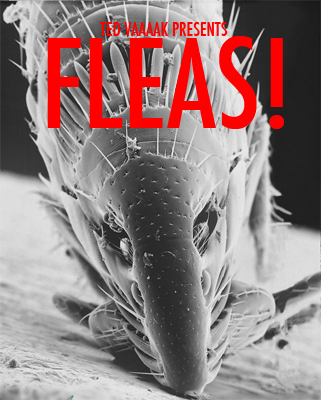
Although Ted Vaaaak’s FLEAS! is largely unremembered now, this was at the time considered evidence – alongside Clive Barker’s Hellraiser and Shuan Hutson’s Slugs – of a renaissance in British horror cinema. Set in a sleepy village in Yorkshire, and starring Brian Glover as a local doctor that has grown up since childhood with a crippling terror of fleas and who now has to confront his worst nightmare, FLEAS! follows almost every single cliche of the murderous flesh-eating innocuous animals genre that was a staple of the 80s horror landscape.
FLEAS! was the first and so far the last film in his indescribable career to have used Ted Vaaaak’s name as a promotional tool, and it has little of the usual confusion associated with the name. Formally one of Vaaaak’s most conventional works, the only scene here that lingers in the memory is the final confrontation between Brian Glover and his mother, who has been nurturing the fleas’ taste for human blood by allowing them to feed on her gargantuan breasts. On discovering that she has taken up residence in his wine cellar, he battles her to the death armed only with a nail gun.
FLEAS! only real lasting legacy probably lies in its successful American remake, Arachnophobia. It is also sometimes considered to be the first work in what would become known as Vaaaak’s “boringness” period, although others argue that this should not be considered a period and more of a phase.
In 2007, Ted Vaaak tried to resurrect this tired genre with his film Fox Hunt, set after the fox-hunting ban and starring David Mitchell as a missionary back from Africa who discovers his idyllic home village overcome by flesh eating foxes hungry for blood, but it was not to prove a success.
***
The Twins Of Death And Disease
Production year: 2013
Country: UK
Language: English
Cert (UK): 18
Runtime: 97 mins
Director: Ted Vaaak
Writer: Ted Vaak
Cast: Jonathan Frakes, John Barrowman, Sally Hawkins
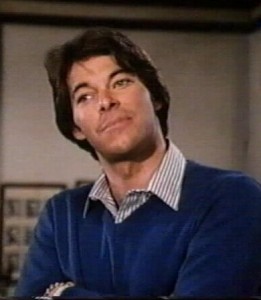
Ted Vaak returns here with a largely pointless and fairly loose remake of David Cronenberg’s 1988 film Dead Ringers. The Twins Of Death And Disease tells the story of twin gynaecologists and their decline and descent into madness, deformity and despair, allowing the director to engage in his usual mix of hysterical misogyny and shuddering kolpophobia.
Due presumably to budget restrictions, the identical twins are here played by a freshly shaved Jonathan Frakes and the waxen smoothity of John Barrowman, which, rather than lessening the horror, instead adds a strange level of disquiet to the proceedings.
Peter Bradshaw is afraid.
***
The Alan Turing Adventures
Production year: 2011
Country: UK
Language: English
Cert (UK): 12A
Runtime: 88 mins
Director: Euros Lyn
Cast: Mark Gatiss, Benedict Cumberbatch
Mark Gatiss, fresh from the success of his adaptation of HG Wells’ The First Men In The Moon, has been given a lavish (by BBC 4 standards) budget to create this pilot for a proposed series of lavish new detective stories, in which he stars as the titular hero. Based upon a never filmed script by recently deceased BBC veteran Ted Vaaak, The Alan Turing Adventures is set during an alternate history Second World War. Turing here has been re-imagined as a dashing and flamboyant secret agent careering around behind enemy lines in a desperate attempt to steal and decode Hitler’s childhood diary, en route to which he gets locked in a deadly game of cat and mouse with Nazi rocketeer Wernher von Braun (Benedict Cumberbatch).
The references to Mark Gatiss’s beloved Doctor Who are legion, with Alan Turing attired almost identically to the Peter Davison-era Doctor, although here, in a subtle nod to history, he carries not a cricket ball but an apple. The final scene, where Turing turns away from von Braun’s smoldering corpse and bites hungrily into this apple is surprisingly poignant.
__________
If you like the things you've read here please consider subscribing to my patreon or my ko-fi. Patreon subscribers get not just early access to content and also the occasional gift, but also my eternal gratitude. Which I'm not sure is very useful, but is certainly very real.(Ko-fi contributors probably only get the gratitude I'm afraid, but please get in touch if you want more). Thank you!
